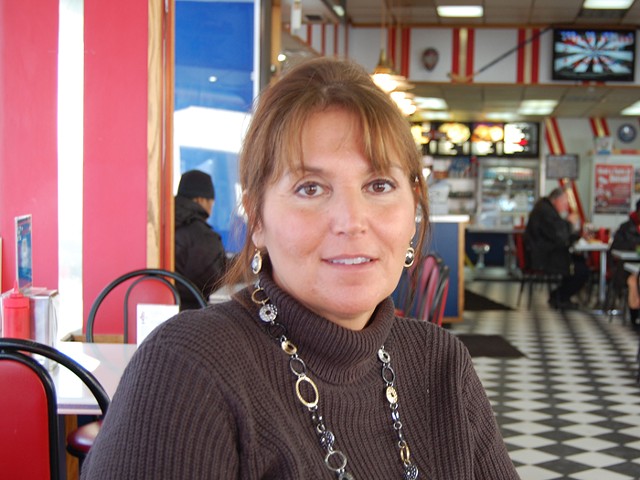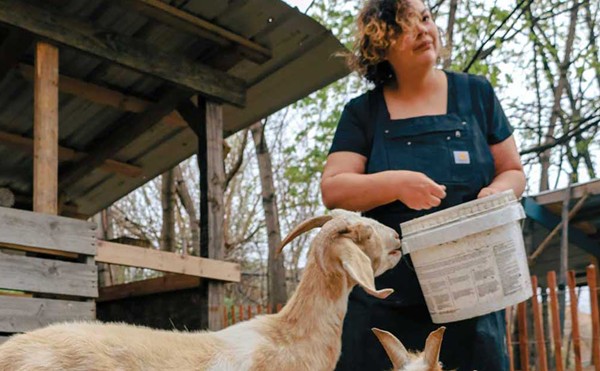Despite the tattoo’s surging mainstream popularity in America — a recent Pew Research Center report indicated 40 percent of millennials fessed up to having at least one — body art still gets a bad rap. More often associated with punks and ne’er-do-wells, tattoos aren’t thought of as works of art the same way as, say, a painting at the DIA.
Artist Tony Caporusso, from Ann Arbor’s Lucky Monkey Tattoo Parlour, admits he didn’t start thinking that way until he got his first traditional tattoo — a hula girl in the style of famed tattoo artist Norman “Sailor Jerry” Collins. “The shop I was frequenting only had one page [of traditional-style art] out there on the wall,” he says, pointing out that the styles that were popular at the time were tribal tattoos and “like, barbarian women with swords.”
“In the early ’90s, it just wasn’t in — it was kind of hard to find,” he says. “I found this one page of flash, and I basically got everything on that page. Then I started talking to the guys in the back and they dropped some names and showed me some books to get.”
Caporusso immersed himself in the world of tattoo art — specifically American traditional tattoo art — reading up on such golden age tattoo artists as Cap Coleman, Sailor Jerry and Paul Rogers. Caporusso started researching the subject academically, digging deeper into the imagery of early American tattooing.
“There’s certain imagery that is connected with American traditional,” Caporusso says, citing nautical and military motifs. “But American traditional is also basically a style. It’s a bold outline, it’s a simplified design, bold color, heavy black shading.” Caprousso explains that besides the actual subject matter, anything that’s applied in that style or technique can be considered a traditional tattoo.
Of course, not every tattoo artist is interested in continuing the legacy of traditional tattoos. Some stand in outright opposition to it, like artist Danielle Felczak of Ann Arbor’s Dolly Llama Tattoos; Felczak deliberately eschews the conventions of that genre. “My style, as far as the tattoo world goes, definitely pushes the limits of what is known as traditional tattoo style,” she says. “There definitely is a difference in my work. A lot of it doesn’t have those thick bold, black lines. It’s softer and more painterly-looking.”
Felczak’s influences come from her own stint as a fine arts student, which gives her a more photo-realistic rendering style. But for Felczak, being a tattoo artist is less about trying to being part of a style and more about finding your own style. “It’s the unique part of each tattooist,” she says. “You get to express yourself artistically in your own way and have your own style just as you would on canvas or paper.”
Tattoo art isn’t exactly like working on canvas or paper, though, and tattoo art doesn’t exactly have a fine arts peer. For one, the tools a tattoo artist uses are unique to tattooing. “You have to get a feel for the weight of the machine, and the vibration it gives when it’s running,” says artist Matt Paw of Highland Township’s Fat Brothers Tattoos. “I’ve tried my hand at a lot of different things: painting, watercolor, oil, acrylic, sculpture, airbrushing. It really doesn’t have another medium that it’s similar to.” Furthermore, tattoo artists have the added challenge of working on a canvas that’s a living, breathing person — and a person in at least some amount of pain.
Felczak says if you had to compare it to anything, tattooing would be most similar to painting. “If you can paint, it easily translates into tattooing,” she says. “A lot of the same color aspects and properties and qualities of the pigments we use, a lot of the needles we use, are similar to using paintbrushes. It’s interconnected. Painting only helps and benefits you.”
What tattooing does have in common with the fine arts is its core foundation. “A lot of it is being an artist, first of all,” Caporusso says. “You have coordination and a steady hand to begin with. It’s strengthening your hand and becoming accustomed to the new medium and tool that you’ll be using.”
When he’s creating his own fine art, Caporusso tries to mirror the process in which traditional tattooing is done. “I lay down the image on watercolor paper, and I outline it in black paint, which is the same as tattooing,” he says. “Then I do the black shading, and then I work my colors from the darkest values to the lightest.”
Paw also works in a similar way when he’s working on art outside of tattooing, but finds that there aren’t as many restrictions in fine art. “I can do a lot of things that tattoos limit,” he says. “I can put little tiny lines next to each other and I don’t have to worry about what that’s going to look like in five years on the skin, because it’s on paper.” He also mixes his own influences into his personal work, like Audubon illustrations, scientific field guides, and the geometric creatures of painter Charley Harper.
Unlike fine art, at its core, tattoo art is a commercial art based on commission, and it can be a challenge for tattoo artists to maintain their own artistic vision in the face of pleasing their clients. “Unfortunately, everybody’s got to make money,” Caporusso says, adding that it’s a blessing when a customer is interested in getting some of his original flash or a custom design in his style: “That’s the highlight of every tattooist’s day.”
“There’s only a certain amount of your style that you can put into certain tattoos,” he says. Caporusso tries to steer his clients into letting him take their idea and do it in his own style without being pushy. “Usually they’re really open-minded and they go along with it, and we get to do a really fun tattoo.”
Felczak, though, laments what the tattoo artists refer to as the recent plague of “Pinterest tattoos” — the trend-of the-minute stuff that clients walk in with after seeing it on the Internet. It’s a challenge, she says, for tattoo artists to make these projects interesting.
“You just try to keep your artistic flair and style to what it is that you’re doing to represent yourself as an artist,” she says.
Like any folk art, the lines of ownership of images in the tattoo world can be blurred. “In the tattoo culture, all this imagery has been redrawn and taken from other people and redone. That’s the kind of attitude and belief system in the industry,” Caporusso says. “If someone does a nice piece of work, you’re not going to take that exact tattoo and do it on somebody else — although it does happen.”
Caporusso uses the example of a traditional tattoo image — a clipper ship with a rose. “A million people have done that,” he says. “You just want to put your own style onto it and not mimic something exactly,” though he admits that, like his own Sailor Jerry hula girl homage, that’s not always the case.
“Unless it’s a classic design from an artist you’re collecting, then that’s OK, because usually that artist has been dead for a long time,” he says.
“It’s a weird belief system,” he admits. “You just have to know what you’re putting on somebody else. If the artist is currently working, you’re not going to take his design and put it on somebody else.” Caporusso pauses. “Unless he sells that design in a sketchbook for sale. Then you’re allowed to do it. It’s tricky! You just have to be aware of what you’re doing.”
Caporusso thinks it’s important for the public to be educated about the artistic aspects of tattoos. “When I got my first tattoo, I knew nothing about the culture, the history. I didn’t even really understand that they were artists,” he says. “I didn’t know it was an almost 200-year-old art form. I try to educate my clients about it when I can. That way they’ll have a more enjoyable experience, and more appreciation for the art.”
Felczak agrees. “There’s a clear definition between someone who just does tattoos and someone who truly is a tattoo artist,” she says. “The tattoo artist will take an idea that someone brings and actually turn it into a piece of artwork that is unique to the person, as opposed to just slapping some drawing that they bring in on their body and calling it a day.
“It’s more than a job. It should be more than a job,” she says. “You’re marking people’s bodies for the rest of their lives. If you’re looking at it like it’s nothing but a job, then maybe you should be working at Wal-Mart.”
The intersection of tattoo art and fine art is celebrated in two art shows, Specimens on Display: Artwork of Matt Paw at the Scarab Club and Beyond the Machine III at the Start Gallery, both running in conjunction with the annual Motor City Tattoo Expo.
Specimens on Display opens 6-10 p.m. Thursday, Feb. 20, at the Scarab Club, 217 Farnsworth St., Detroit; 313-831-1250.
Beyond the Machine III opens 7-11 p.m. Saturday, Feb. 22, at the Start Gallery, 206 E. Grand River Ave., Second Floor, Detroit; 313-909-2845.






